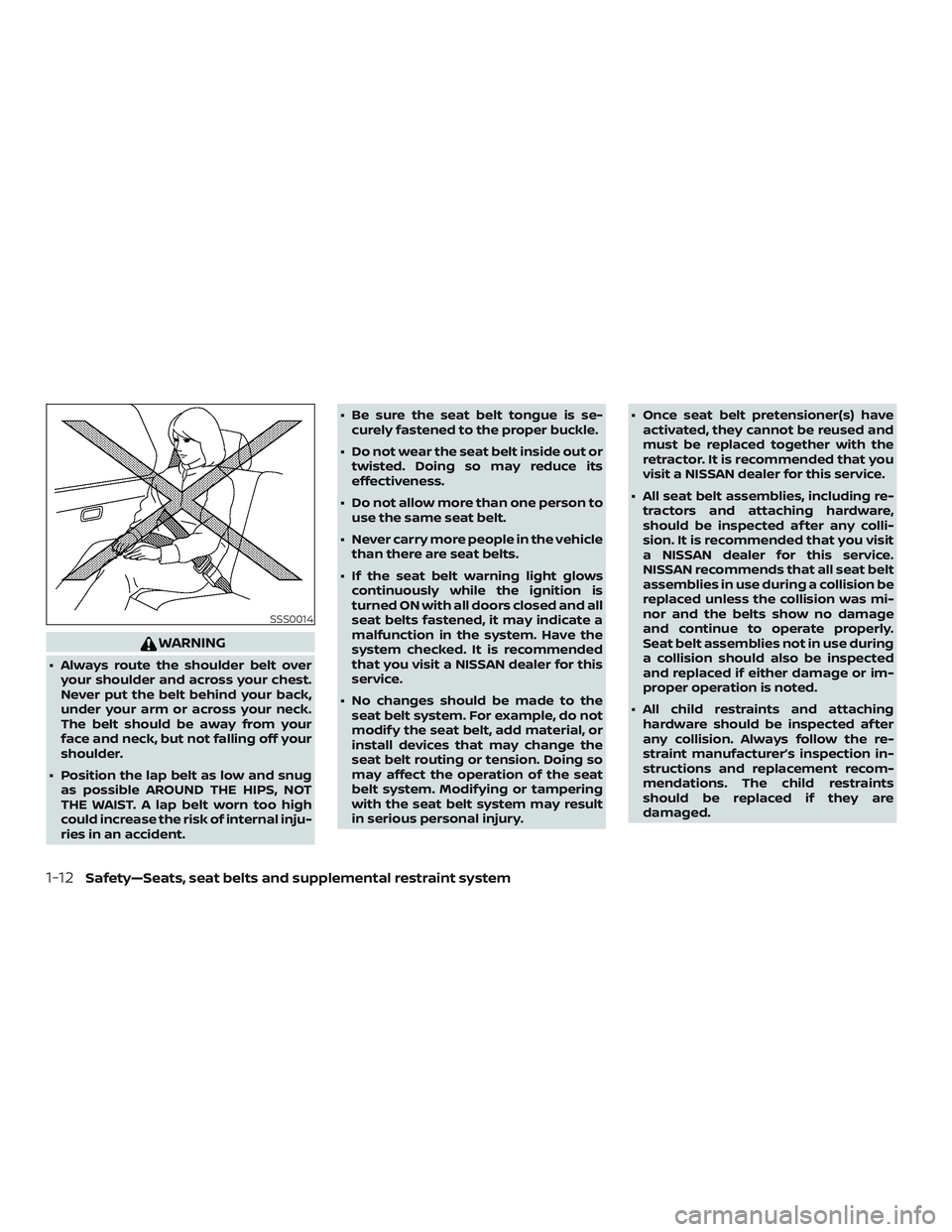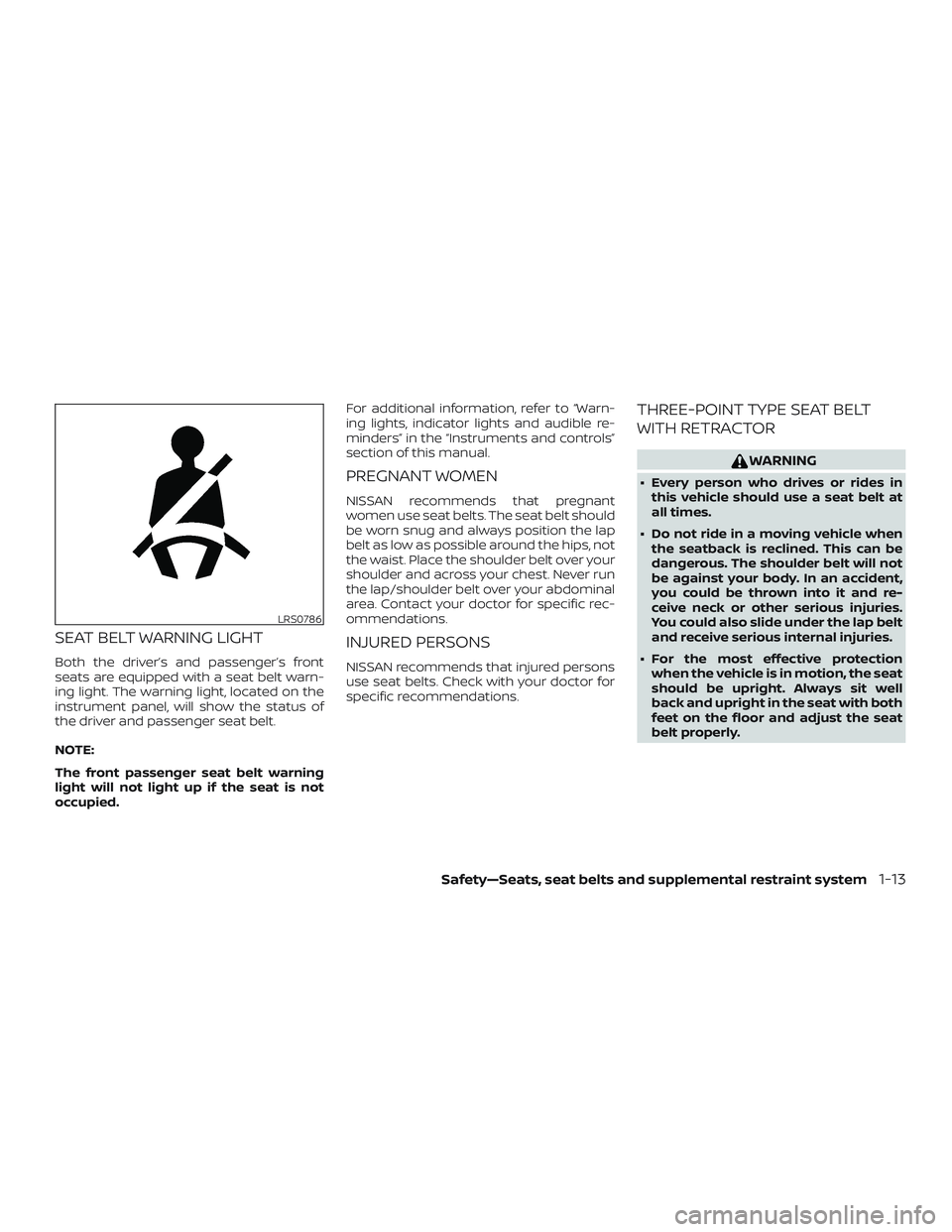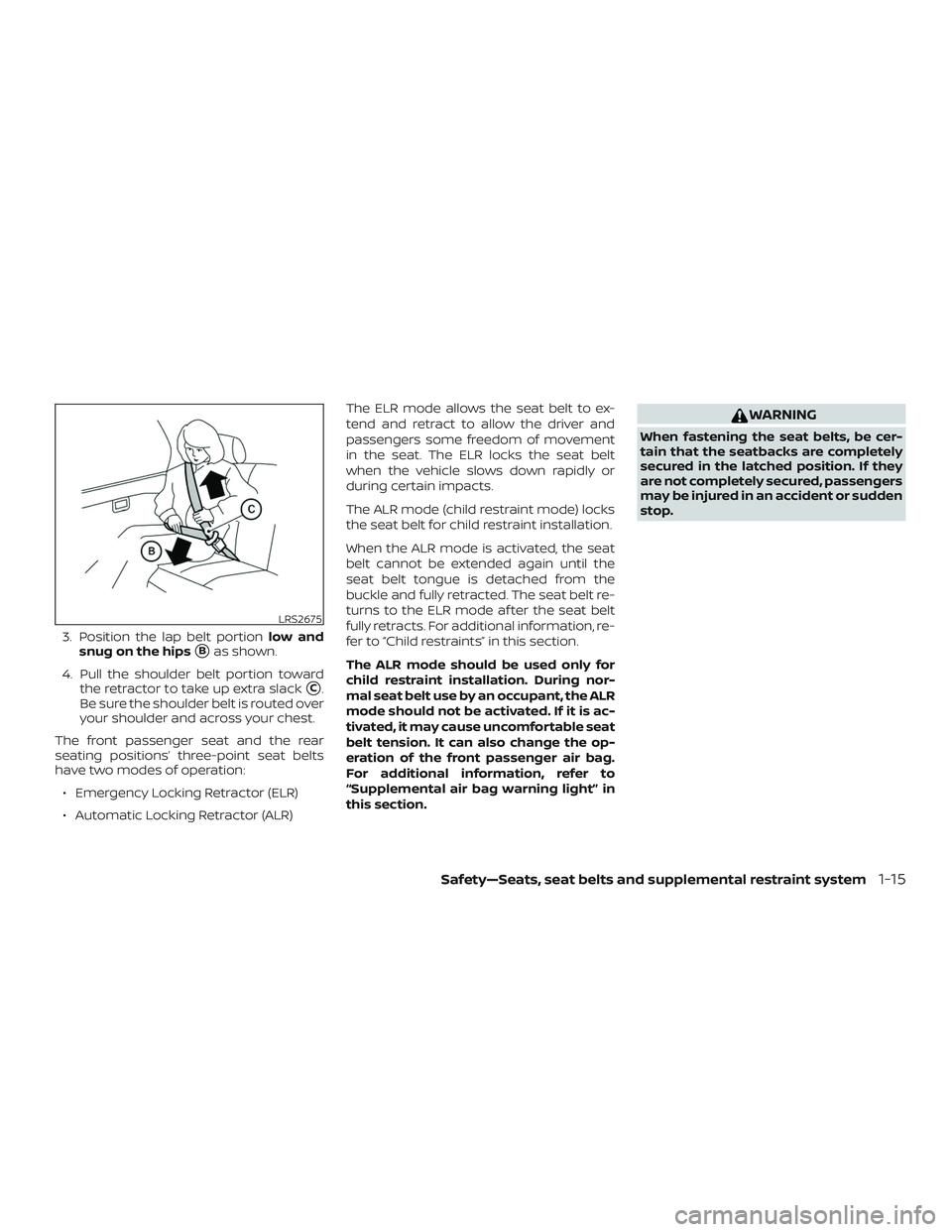Page 460 of 878

ARMREST (if so equipped for
driver’s side only)
To use the armrest, pull it down as shown.
�AStowed position
�BResting position
WARNING
Head restraints/headrests supplement
the other vehicle safety systems. They
may provide additional protection
against injury in certain rear end colli-
sions. Adjustable head
restraints/headrests must be adjusted
properly, as specified in this section.
Check the adjustment af ter someone
else uses the seat. Do not attach any-
thing to the head restraint/headrest
stalks or remove the head
restraint/headrest. Do not use the seat
if the head restraint/headrest has been
removed. If the head restraint/headrest
was removed, reinstall and properly ad-
just the head restraint/headrest before
an occupant uses the seating position.
Failure to follow these instructions can
reduce the effectiveness of the head
restraints/headrests. This may in-
crease the risk of serious injury or death
in a collision.The illustration shows the seating posi-
tions equipped with head
restraints/headrests.
�
Indicates the seating position is
equipped with a head restraint.
� Indicates the seating position is equipped
with a headrest.
+ Indicates the seating position is not
equipped with a head restraint or headrest
(if applicable).
∙ Your vehicle is equipped with a head restraint/headrest that may be inte-
grated, adjustable or non-adjustable.
LRS2454LRS2000
HEAD RESTRAINTS/HEADRESTS
1-6Safety—Seats, seat belts and supplemental restraint system
Page 465 of 878
WARNING
∙ Every person who drives or rides inthis vehicle should use a seat belt at
all times. Children should be in the
rear seats and in an appropriate
restraint.
WARNING
∙ The seat belt should be properly ad-justed to a snug fit. Failure to do so
may reduce the effectiveness of the
entire restraint system and increase
the chance or severity of injury in an
accident. Serious injury or death can
occur if the seat belt is not worn
properly.
SSS0134SSS0016
Safety—Seats, seat belts and supplemental restraint system1-11
Page 466 of 878

WARNING
∙ Always route the shoulder belt overyour shoulder and across your chest.
Never put the belt behind your back,
under your arm or across your neck.
The belt should be away from your
face and neck, but not falling off your
shoulder.
∙ Position the lap belt as low and snug as possible AROUND THE HIPS, NOT
THE WAIST. A lap belt worn too high
could increase the risk of internal inju-
ries in an accident. ∙ Be sure the seat belt tongue is se-
curely fastened to the proper buckle.
∙ Do not wear the seat belt inside out or twisted. Doing so may reduce its
effectiveness.
∙ Do not allow more than one person to use the same seat belt.
∙ Never carry more people in the vehicle than there are seat belts.
∙ If the seat belt warning light glows continuously while the ignition is
turned ON with all doors closed and all
seat belts fastened, it may indicate a
malfunction in the system. Have the
system checked. It is recommended
that you visit a NISSAN dealer for this
service.
∙ No changes should be made to the seat belt system. For example, do not
modif y the seat belt, add material, or
install devices that may change the
seat belt routing or tension. Doing so
may affect the operation of the seat
belt system. Modif ying or tampering
with the seat belt system may result
in serious personal injury. ∙ Once seat belt pretensioner(s) have
activated, they cannot be reused and
must be replaced together with the
retractor. It is recommended that you
visit a NISSAN dealer for this service.
∙ All seat belt assemblies, including re- tractors and attaching hardware,
should be inspected af ter any colli-
sion. It is recommended that you visit
a NISSAN dealer for this service.
NISSAN recommends that all seat belt
assemblies in use during a collision be
replaced unless the collision was mi-
nor and the belts show no damage
and continue to operate properly.
Seat belt assemblies not in use during
a collision should also be inspected
and replaced if either damage or im-
proper operation is noted.
∙ All child restraints and attaching hardware should be inspected af ter
any collision. Always follow the re-
straint manufacturer’s inspection in-
structions and replacement recom-
mendations. The child restraints
should be replaced if they are
damaged.
SSS0014
1-12Safety—Seats, seat belts and supplemental restraint system
Page 467 of 878

SEAT BELT WARNING LIGHT
Both the driver’s and passenger’s front
seats are equipped with a seat belt warn-
ing light. The warning light, located on the
instrument panel, will show the status of
the driver and passenger seat belt.
NOTE:
The front passenger seat belt warning
light will not light up if the seat is not
occupied.For additional information, refer to “Warn-
ing lights, indicator lights and audible re-
minders” in the “Instruments and controls”
section of this manual.
PREGNANT WOMEN
NISSAN recommends that pregnant
women use seat belts. The seat belt should
be worn snug and always position the lap
belt as low as possible around the hips, not
the waist. Place the shoulder belt over your
shoulder and across your chest. Never run
the lap/shoulder belt over your abdominal
area. Contact your doctor for specific rec-
ommendations.
INJURED PERSONS
NISSAN recommends that injured persons
use seat belts. Check with your doctor for
specific recommendations.
THREE-POINT TYPE SEAT BELT
WITH RETRACTOR
WARNING
∙ Every person who drives or rides in
this vehicle should use a seat belt at
all times.
∙ Do not ride in a moving vehicle when the seatback is reclined. This can be
dangerous. The shoulder belt will not
be against your body. In an accident,
you could be thrown into it and re-
ceive neck or other serious injuries.
You could also slide under the lap belt
and receive serious internal injuries.
∙ For the most effective protection when the vehicle is in motion, the seat
should be upright. Always sit well
back and upright in the seat with both
feet on the floor and adjust the seat
belt properly.
LRS0786
Safety—Seats, seat belts and supplemental restraint system1-13
Page 469 of 878

3. Position the lap belt portionlow and
snug on the hips
�Bas shown.
4. Pull the shoulder belt portion toward the retractor to take up extra slack
�C.
Be sure the shoulder belt is routed over
your shoulder and across your chest.
The front passenger seat and the rear
seating positions’ three-point seat belts
have two modes of operation: ∙ Emergency Locking Retractor (ELR)
∙ Automatic Locking Retractor (ALR) The ELR mode allows the seat belt to ex-
tend and retract to allow the driver and
passengers some freedom of movement
in the seat. The ELR locks the seat belt
when the vehicle slows down rapidly or
during certain impacts.
The ALR mode (child restraint mode) locks
the seat belt for child restraint installation.
When the ALR mode is activated, the seat
belt cannot be extended again until the
seat belt tongue is detached from the
buckle and fully retracted. The seat belt re-
turns to the ELR mode af ter the seat belt
fully retracts. For additional information, re-
fer to “Child restraints” in this section.
The ALR mode should be used only for
child restraint installation. During nor-
mal seat belt use by an occupant, the ALR
mode should not be activated. If it is ac-
tivated, it may cause uncomfortable seat
belt tension. It can also change the op-
eration of the front passenger air bag.
For additional information, refer to
“Supplemental air bag warning light” in
this section.
WARNING
When fastening the seat belts, be cer-
tain that the seatbacks are completely
secured in the latched position. If they
are not completely secured, passengers
may be injured in an accident or sudden
stop.
LRS2675
Safety—Seats, seat belts and supplemental restraint system1-15
Page 471 of 878

WARNING
∙ Always fasten the connector tongueand the seat belt in the order shown.
∙ Always make sure both the connector tongue and the seat belt tongue are
secured when using the seat belt or
installing a child restraint. Do not use
the seat belt or child restraint with
only the seat belt tongue attached.
This could result in serious personal
injury in case of an accident or a sud-
den stop. Stowing the center seat belt
When folding down the rear seat, the rear
center seat belt can be retracted into a
stowed position. 1. Hold the connector tongue
�1so that
the seat belt does not retract suddenly
when the tongue is released from the
connector buckle. Release the connec-
tor tongue by inserting a suitable tool
such as a key
�2into the connector
buckle.
2. Retract the seat belt and store the seat belt tongue on the stowed position
�3.
WARNING
Do not unfasten the rear center seat
belt connector except when folding
down the rear seat.
SSS0241
LRS8100
Safety—Seats, seat belts and supplemental restraint system1-17
Page 472 of 878
Attaching the center seat belt
Always be sure the center seat belt con-
nector tongue and connector buckle are
attached. Disconnect only when folding
down the rear seat.To connect the buckle:
1. Pull the seat belt tongue and connector tongue from the stowed position
�1.
2. Pull the seat belt and secure the con- nector buckle until it clicks
�2.
The center seat belt connector tongue can
be attached only into the rear center seat
belt connector buckle.
To fasten the seat belt, refer to “Fastening
the seat belts” in this section.
WARNING
∙ When attaching the rear center seat belt connector, be certain that the
seatbacks are completely secured in
the latched position and the rear cen-
ter seat belt connector is completely
secured.
∙ If the rear center seat belt connector and the seatbacks are not secured in
the correct position, serious personal
injury may result in an accident or
sudden stop.
LRS8101
LRS8102
1-18Safety—Seats, seat belts and supplemental restraint system
Page 473 of 878

∙ Make sure to wear the rear center seatbelt with the seat belt passing
through the path
�A.
Shoulder belt height adjustment
(front seats)
The shoulder belt anchor height should be
adjusted to the position best for you. For
additional information, refer to “Precau-
tions on seat belt usage” in this section. To
adjust, pull out the adjustment button
�1
and move the shoulder belt anchor to the
desired position
�2, so the belt passes over
the center of the shoulder. The belt should
be away from your face and neck, but not
falling off your shoulder. Release the ad-
justment button to lock the shoulder belt
anchor into position.
WARNING
∙ Af ter adjustment, release the adjust- ment button and try to move the
shoulder belt anchor up and down to
make sure it is securely fixed in
position.
∙ The shoulder belt anchor height should be adjusted to the position
best for you. Failure to do so may re-
duce the effectiveness of the entire
restraint system and increase the
chance or severity of injury in an
accident.
SEAT BELT EXTENDERS
If, because of body size or driving position, it
is not possible to properly fit the
lap/shoulder belt and fasten it, an extender
that is compatible with the installed seat
belts is available for purchase. The ex-
tender adds approximately 8 in (200 mm)
of length and may be used for either the
driver or front passenger seating position.
It is recommended that you visit a NISSAN
dealer for assistance with purchasing an
extender if an extender is required.
LRS0242
Safety—Seats, seat belts and supplemental restraint system1-19